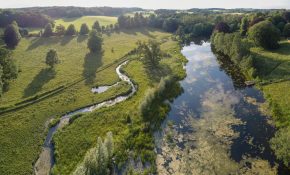Dr Jonathan Grey visits the River Nar and tells us all about it!
Monday September 8th, 2014
Earlier this week I spent a couple of days poking around in rivers (as I am prone to do) but quite shamefully it was my first visit to two of Norfolk’s gems, the Bure and the Nar. Monday was a bit of a wash out in terms of persistent drizzle and dark, dank clouds. Perhaps this was a portentous backdrop to the ominous number of invasive non-native crayfish bulldozing around the bed of the Bure? If the weather was truly a reflection of ecosystem health (and my mood), then it was no surprise Tuesday dawned bright and sunny, for I was off to see the Nar at Castle Acre.
I’d met my host, Charles Rangeley-Wilson, through our common interests of chalkstreams and trout and had chewed the fat at a recent Wild Trout Trust get-together. While the primary reason for my Norfolk foray was the crayfish problem, I couldn’t pass up the opportunity to see the restoration work in progress on the Nar. First glimpses revealed an all too common fate for these iconic rivers – too wide and shallow in some areas, and over-deepened and over-full of eel grass and burr reed in others.
But there in between for several hundreds of metres, the river was back to its former glory, happily chuckling along over gleaming gravels and bustling its way past swaying water crowfoot. Charles and co. have revitalised stretches by narrowing and pinching, and by using local riparian trees as the raw materials, they have let in the light. This is absolutely essential if the bank side plants are to reclaim the modified berms and bind the shifted sediments, and of course for the in-stream plants.
At first sight, the work may appear quite brutal but it needs to be if it is to undo the injustices inflicted in the past. Of utmost importance though, it has all been sensitively aligned to the whims of the river as evidenced by the tell-tale sorting of bed sediments. What was once a barren bed of fine silts, ingress from the wider catchment, is now reasserting itself into a mosaic of cobbles, gravels and sand, as well as luxuriant stands of crowfoot and starwort of course.
And the trout? Well, they seemed incredibly happy, as was I to share their ‘new’ habitat for the afternoon.
What more can I say? Exemplary work from the Norfolk Rivers Trust. Go and see it for yourself!
Dr Jonathan Grey, September 2014

Large woody debris on the River Nar at Castle Acre with Charles Rangeley-Wilson






